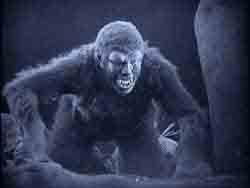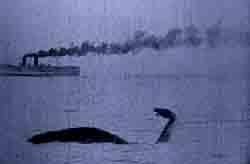But the creatures in Harry Hoyt's classic silent The Lost World are a little more ambivalent.
Located in the heart of deepest, darkest Latin America, far up the Amazon somewhere at the confluence of Brazil, Colombia, and Peru, they certainly instantiate peripheral under-development.
 Moreover, these lumbering beasts occupy what is merely one end of a continuum: they share their plateau homeland with both apes and rather menacing apemen. Down below, in the tropical jungle, are snakes, alligators, sloths, and human "half-breeds," the zambo half black, half Indian. Also left behind in camp, while the main exploring party go on above to search for signs of the previous expedition in the area, is Austin, an English domestic servant. The main party itself is divided between the old and more or less unfit (Professor Summerlee) and the young and nubile, not least the journalist Malone who proves his worth as a husband by braving the South American wilderness, so winning Paula White as female prize from the veteran explorer Sir John Roxton.
Moreover, these lumbering beasts occupy what is merely one end of a continuum: they share their plateau homeland with both apes and rather menacing apemen. Down below, in the tropical jungle, are snakes, alligators, sloths, and human "half-breeds," the zambo half black, half Indian. Also left behind in camp, while the main exploring party go on above to search for signs of the previous expedition in the area, is Austin, an English domestic servant. The main party itself is divided between the old and more or less unfit (Professor Summerlee) and the young and nubile, not least the journalist Malone who proves his worth as a husband by braving the South American wilderness, so winning Paula White as female prize from the veteran explorer Sir John Roxton.But this hierarchy is not entirely stable: Jocko, the pet monkey, is (as Summerlee is reminded) more useful than some of the human members of the group; and Professor Challenger himself often (as Deleuze and Guattari point out) appears half-simian, hirsute and hot-headed, becoming-animal in his enthusiasm and stubbornness, and, not least, his vitriol against the written word.
Moreover, if the Conan Doyle novel on which the movie is based frames Challenger's expedition as a civilising mission, concluding with the apemen wiped out or enslaved and a client regime of grateful natives installed on the plateau, the film version differs sharply. Here, the "lost world" is devastated by a sudden volcanic eruption. One brontosaurus, however, escapes and is taken back to London--only there to escape again, cause mayhem in the streets, and collapse the iconic Tower Bridge, before, in the film's final frames, heading back towards Latin America by sea.

At the head of the tradition of monster movies that it initiates (animator Willis O'Brien would go on to work on King Kong, in many ways a remake of this film), The Lost World introduces a preoccupation with the monster as a genie disturbed, its vengeance a return for modern hubris. In this, of course, Spielberg's own Lost World is a true inheritor.
But if Spielberg's emphasis is on the dangers of science over-reaching itself, is not Harry Hoyt's theme imperial decline, his fear (and the fear radiated in the innumerable close-up reaction shots of Bessie Love playing Paula White) that of the untamed forces of what was once thought natural terrain for colonial intervention?
(Crossposted from Latin America on Screen.)
No comments:
Post a Comment